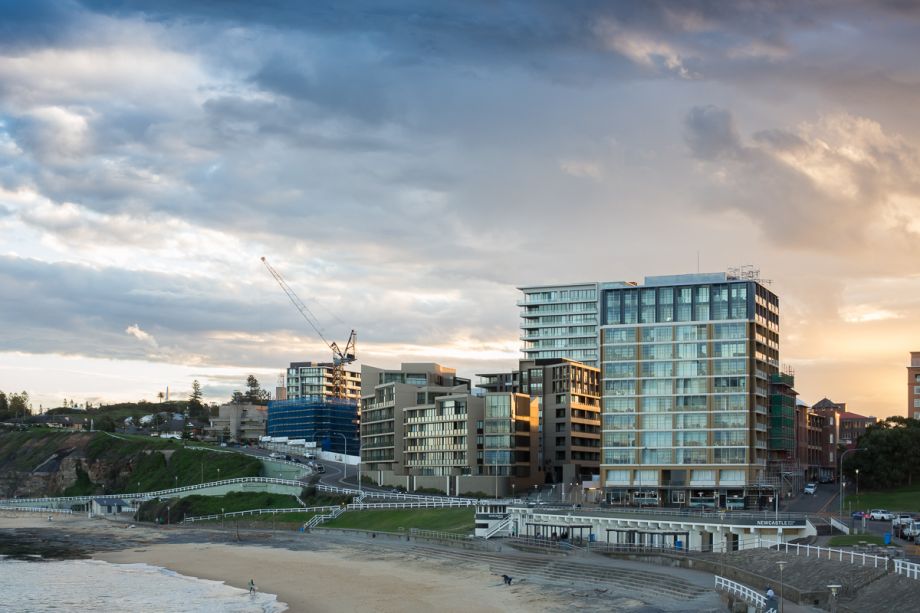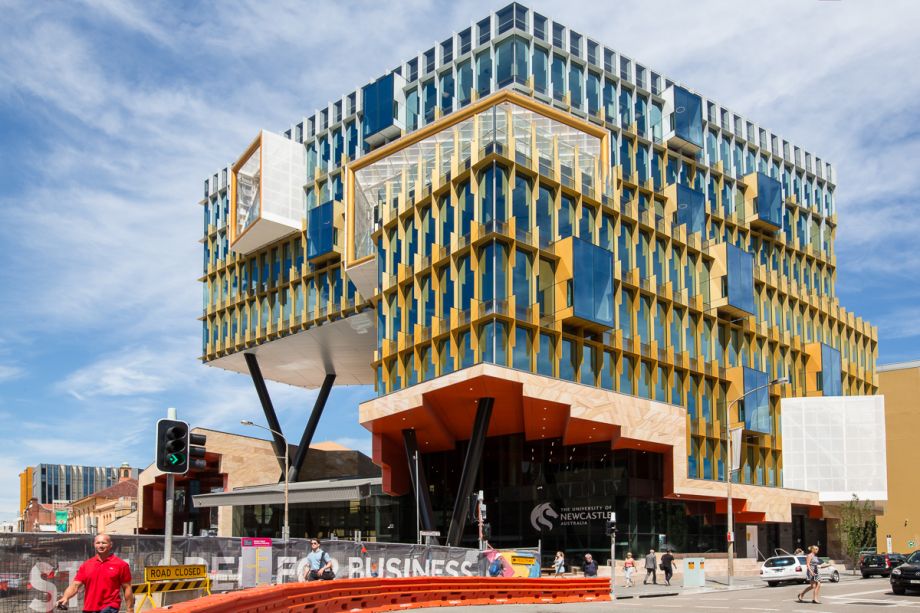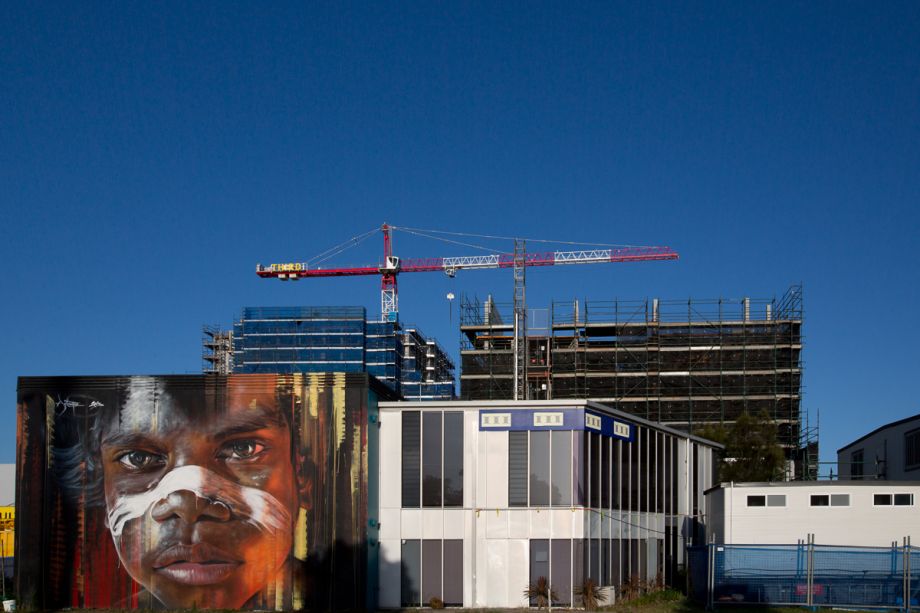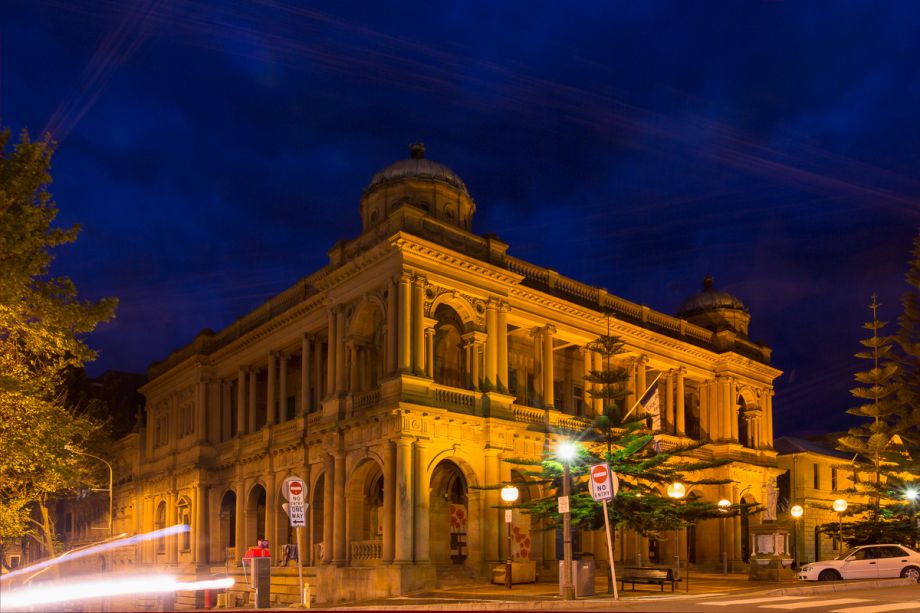Are You A Vanguard? Applications Now Open
When you think of Australian cities, Sydney and Melbourne come to mind, and perhaps even the nation’s capital, Canberra, but not Newcastle, a historic city with a booming port and an industrial pedigree.
Yet the beachside city is Australia’s seventh largest and growing, both in population and ambition, as it reinvents itself for the 21st century.
The city’s new vision, says Lord Mayor Nuatali Nelmes, “is to be a smart, livable and sustainable city.”
Over the past decade, city, regional and state leaders have recognized that industries such as coal that created the city will not be the same ones to propel it forward. Not in a rapidly changing world defined by new challenges such as climate change, widening inequality and a rapid-paced global economy wherein knowledge is the most prized export.

View from Newcastle Beach to the coveted East End of the inner city. The main glass-fronted building shows the relatively recent development of the old hospital into modern apartments.
More than half a billion dollars in public investment is going to help Newcastle fulfill its vision and compete not just with the city’s past self, but also with larger global cities, including Sydney just 100 miles (161 kilometers) down the world-famous New South Wales coastline. The state funds are going toward revitalizing the city center, supporting the growth of the University of Newcastle, and building a new $500 million light-rail system that will connect to existing ferry and bus routes. Perhaps more impressively, the public cash flow has set off a run of private investment.
With old warehouses transforming into stylish loft residences and sleek apartment buildings rising on long vacant corners, new residents — including many natives who had fled years earlier for opportunities in larger cities — are flocking to an urban core that had bled residents for decades. With more than 160,000 people living within city limits last year and approximately 500,000 living in the metropolitan region, Newcastle’s population has surpassed its 1971 peak and city officials expect the population to grow by 26 percent by 2036.
Coal is still Newcastle’s main export, but other goods are increasingly finding themselves moving in and out of the city. With a major new cruise terminal slated to open on the harbor next year, tourists are among the inflow.

University of Newcastle’s NeW Space complex stands in the city's Central Business District.
The modern city of Newcastle traces its roots back to a British naval officer named John Shortland who sailed into the region searching for convicts who had escaped from Sydney, then a penal colony. In records of his travel, he described the waterway today known as the Hunter River as a “very fine coal river.”
But by the time Shortland and other colonists discovered the valuable land to the north of Sydney, it was long occupied as the country of three Aboriginal groups: the Awabakal, the Worimi and the Mindaribba peoples. Their presence did not deter Shortland. Over the next few years, ships sailed to the Hunter in search of coal and by 1799, a first export of the black gold sailed up the Hunter to the sea and to India. That shipment is known as the first commodity export from modern Australia, and for the next 100 years, coal would define Newcastle and drive its growth.
That economic order changed in 1915 when the international resource giant BHP Billiton opened a major steelworks just a few miles from the Central Business District. Coal City became Steel City. For 85 years until the year 2000, the plant’s smokestacks loomed large over the city’s culture and coffers. Virtually everyone in Newcastle can name a family member or friend who worked at “The BHP,” as it was known. When the steelworks closed 18 years ago, some 2,000 people lost their jobs and many people across the region feared that the closure would trigger the city’s demise. But almost immediately, silver linings became evident. Air quality improved. Young people began thinking more creatively about their career options. Leaders across the region began talking to one another about what was next. With the assistance of a $30 million fund established by the New South Wales government and BHP, Newcastle began a process of rebirth. There was already some diversity to the local economy and the social fabric, but the city had let itself be defined solely by its industrial heritage. City and state leaders began to think about how to take advantage of the city’s other assets: its beautiful beachfront environment, a growing health and education sector supported by the University of Newcastle, an advanced manufacturing sector, renewable energy resources, and mining services sectors.
At the same time that the city was taking stock of its assets, it was moving forward with a plan to clean and redevelop unused industrial wharf and rail workshop areas that for generations had divided people from the sparkling harbor just beyond the city’s downtown center. Honeysuckle, as the project was known, became one of the biggest urban renewal successes in Australia. It is now a 2.5-mile-long waterfront park incorporating residential, dining and entertainment areas.
But even after the steelworks closed and Honeysuckle showed the city that industry wasn’t the only way to create jobs on the water, coal loomed large in the local economy. The commodity that drew European settlers to Newcastle in the 18th century never stopped flowing from the mines of the Hunter Valley. Through the aughts, a booming coal market diverted resources and lessened the need to do the hard work required to focus on further renewal and economic diversification. But when the mining bonanza slowed and unemployment rose several years ago, attention turned again to diversification and urban renewal.
The success of Honeysuckle, in part, assisted in the continued decline of Newcastle’s Central Business District (CBD) and long main shopping street. Employers and people had moved to the new waterfront area. An innovative community-driven program Renew Newcastle made inroads through the creative use of empty buildings that has since been adopted in other cities. But by itself, it was not enough to transform a city.
One big challenge was a 1.2-mile heavy rail line that extended almost to the end of the peninsula, creating a barrier between the CBD, the harbor and Honeysuckle. For decades, Novocastrians argued about whether the railroad line still belonged downtown until finally in 2013, public officials decided to close the CBD section of the heavy rail line and replace it with light rail. Other investments followed, including a new cruise ship terminal that’s expected to open at the end of 2018 and create a steady flow of tourists who will be able to hop on shore and catch a train to attractions across the city. All of this is happening under the banner of a $650 million Revitalising Newcastle program that aims to leverage its investments in infrastructure and public assets to attract more private development.
Michael Cassel is the director of the program and the chief executive of Hunter Development Corporation, the regional economy development agency. A Sydney-based real estate industry veteran who worked in Abu Dhabi before taking over the reins at HDC, he is bullish on Newcastle. He says his team’s role is to activate the city to attract people, jobs and tourism. Practically, that means: the construction of a wire-free light-rail system to replace the heavy rail; a new transport interchange center; new road, pedestrian and bike lane connections between the city and waterfront and new housing; and attractive public spaces right along the new transit networks. The first stage of a new transport interchange opened ahead of schedule last month.

Michael Cassel of Revitalising Newcastle stands at Newcastle’s historic train station, which is currently undergoing a transformation.
Cassel and other civic leaders share a view that not all development is good development and have advocated for contextual zoning policies that allow for soaring towers in some sections of the city but maintain the historic low-rise character of other sections.
“Once an afterthought, standards are being set with high-quality architecture and as public domain designs a part of development bids,” Cassel says.
The public investment has paid off, catalyzing skyrocketing levels of private investment, says Lord Mayor Nelmes. In the last fiscal year, the City Council approved a record $1 billion worth of development applications, double the prior year’s total. Already, this year’s development total is set to exceed $1 billion.
As growth takes off, the mayor has put a renewed focus on ensuring the city remains affordable and inclusive. After all, part of the reason why Newcastle is growing so rapidly is because Sydney down the road is no longer affordable to the average New South Wales resident. Through smart planning, Nelmes hopes to avoid that fate.
“We need integrated transport but we also need to integrate transport with land use planning to ensure great public spaces, affordable housing and short commuting times for all,” she says.

A new three-tower apartment complex is rising in Wickham facing Newcastle Harbour. In front of the construction is street art on a shipping container by Adnate.
Nelmes isn’t the first mayor to try her hand at turning around Newcastle. Planning failures dogged previous revitalization efforts. Now, there are several plans that appear to have broad support and share similar themes of innovation and technology, job creation for the future of work, and sustainability. The New South Wales government’s Hunter Regional Plan 2036 as well as City Council’s Newcastle Smart City Strategy 2017-2021 and Newcastle 2030 community strategic plan all shake off industrial heritage and detail strategies to create a vibrant, sophisticated, diverse, technology-focused city.
But plans need to be implemented. Collaboration is the word the lord mayor uses when asked for the critical factor in the city’s transformation. She is from the Labor (similar to Democrats in the U.S.) side of politics while the current NSW government is Liberal (similar to Republicans).
Nelmes says council, the NSW government and business have put politics aside to focus on priority areas where they can agree and have most benefit to the community.
The collaboration is evident in ways large and small, ranging from a planned free public WiFi system and the forward movement of the light rail to a recent announcement of a new park and ride system from the city’s parking-rich sports stadium to the CBD to counteract reduced parking and increased congestion.
One of the most meaningful collaborations to date is that among the mayor, the state and the University of Newcastle, a research university ranked in the top 3 percent of universities worldwide. With investment support from the NSW government, the university recently opened a futuristic-looking CBD campus, creating an eye-catching beacon to attract students and university staff into the city to study and live. Next up for the 50-year-old university is an Innovation Hub building on its existing industry research projects and partnerships.
There are still issues to overcome. The city’s grand former Post Office and the old heavy rail station are both now vacant and in the early phases of redevelopment. The former steelworks site still sits idle.

The historic Newcastle Post Office building at night
There is also still the resistance to trading in cars for public transit. Decades of poor transportation service shaped habits that are hard to break and while civic leaders are adopting a “build it and they will come” attitude, there is no guarantee that people will take the bait.
But if you ask Nelmes, there are plenty of indicators that they will. She says the secret of Newcastle is now out. She says local people and others have started to see Newcastle for what it is: a beautiful place to live, with a host of natural advantages including sun-drenched surf beaches, and a great sense of community.
“Our proximity to Sydney with more affordable housing and great lifestyle is our competitive advantage,” Nelmes says. “We are uniquely placed to seize on that advantage to transform our city.”
Craig Eardley is a Novocastrian who saw the light 20 years ago and moved to the city from Sydney.

Edwina Richards is a freelance photographer based in Newcastle, NSW. Richards holds a Master of Art Photomedia (UNSW), B/A Communications (University of Newcastle) and has worked in various roles in the Australian media, film and art industries. Since 2009, she has been a part of the not-for-profit urban regeneration organisation Renew Newcastle.

20th Anniversary Solutions of the Year magazine